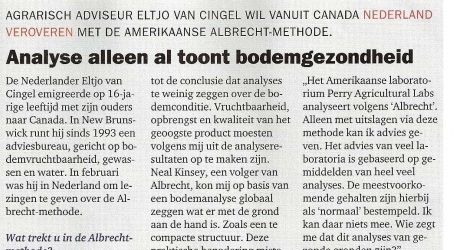
A balanced soil is the way to a healthier plant, higher yields and a healthier product. This was already stated in the 1920’s by Dr. William Albrecht. According to Albrecht, only a balanced soil can produce healthy food with the proper mineral ratios. His system of analysis determines exactely how much is needed of each nutrient.
Neal Kinsey has been teaching the Albrecht system since the passing of Dr. Albrecht. He has improved the system over the years and has been working with many consultants all over the world. One of them is Eltjo van Cingel.
In short, the Albrecht system is all about balancing of nutrients so that the plant has access to all of the nutrients. The difference between the Albrecht system and others is that the Albrecht system not only looks at the deficient nutrients but also at those which are in excess. Having to much of certain nutrients blocks the availability of other nutrients which prevents the plant from taking it up.
Ideal soil
According to Albrecht the ideal soil is made up of 45% minerals, 5% humus and 50% air. Ideally, the air pockets are made up of 50% water and 50% oxygen which is needed for the life in the soil. Having a proper balance of soil nutrients will affect the microbial activity in the soil and therefore growth of the crop. Crop rotation and tillage will off course also play an important role here.
Through the soil and leaf, Albrecht and Kinsey balance the nutrients in the plant. Foliar feeding is used because the soil cannot be balanced in one year. However, foliar feeding is still important after the soil is in balance. In the Spring, the rapid growth, small root system and cold soil temperatures prevent adequate uptake of nutrients. Foliar feeding also works during dry growing conditions when nutrient uptake through the roots is limited.
Specific nutrient applications
Soil nutrients can be too high causing other nutrients to be deficient eventhough there is enough present in the soil. An example is Zinc. There may be enough Zinc in the soil but with excess Phosphate, the plant cannot take up Zinc. The nutrients block each other which is why Zinc is no longer available. “Therefore, a fertilizer program is not just a matter of only adding those nutrients which are deficient according to the soil report” according to Van Cingel. One nutrient can affect the availability of another nutrient. Too much Magnesium decreases the availability of Calcium and Potassium. When there is enough soil Magnesium but not enough Calcium, more Magnesium should be applied in addition to the Calcium. Applying Calcium reduces the Magnesium availability
This is one of the reasons why a specific recommendation is given for each soil type and situation.

Attachments



